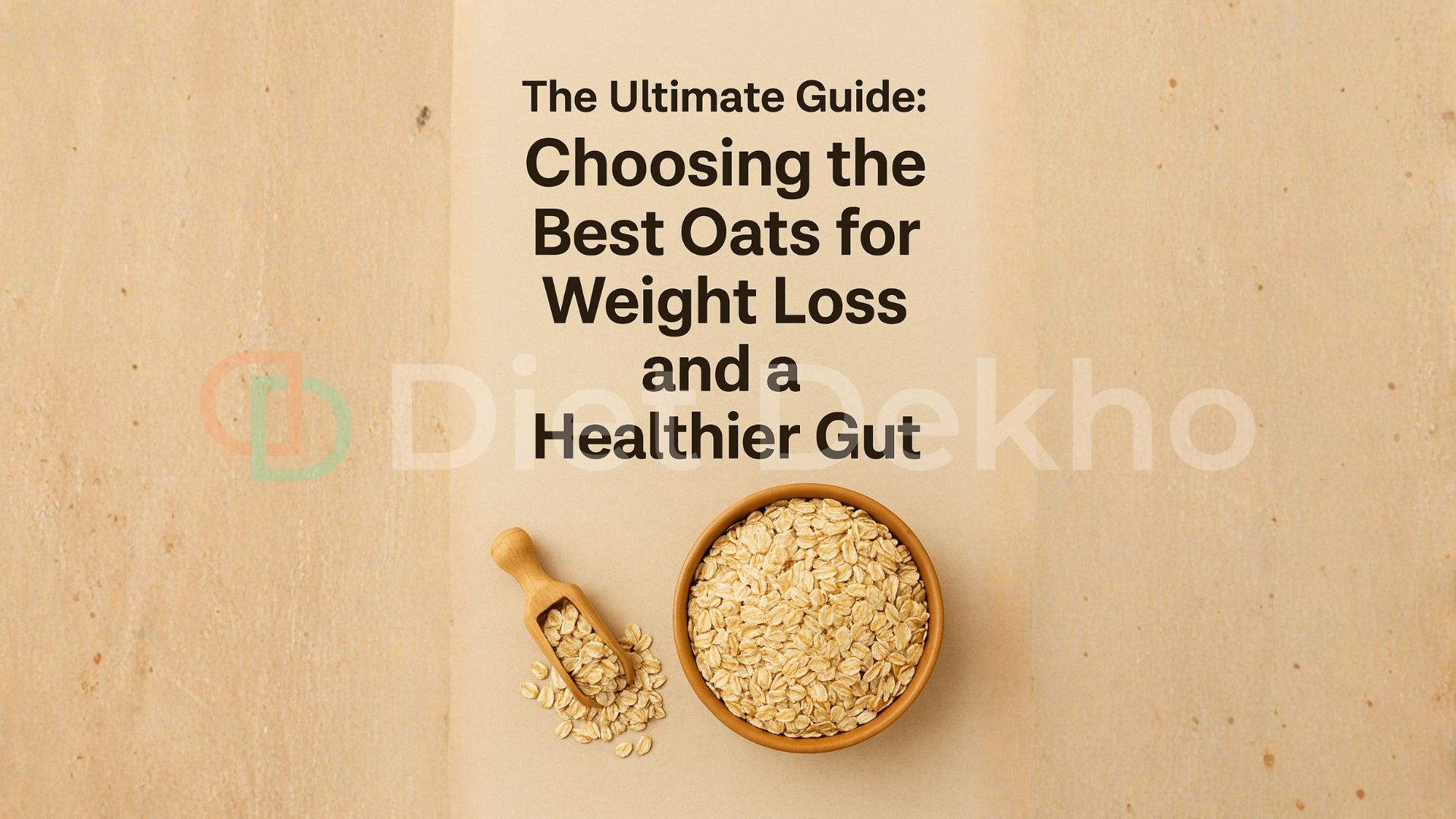Losing weight often feels like a constant battle against hunger. Dieters frequently report feeling unsatisfied and battling powerful cravings, making sustainable weight loss an immense challenge. The key to success is not simply cutting calories, but intelligently maximizing satiety—the feeling of fullness—for every calorie consumed. This foundational approach allows individuals to naturally reduce overall calorie intake without the struggle of constant deprivation. Oats, a humble staple, represent one of the most powerful foods available for shifting the dial on hunger and supporting long-term metabolic health.
This report explores why oats are exceptionally effective for weight loss, detailing the critical differences between the types available on store shelves. The focus moves beyond macro counts to analyze how the structure and preparation of different oats influence blood sugar control, gut health, and appetite suppression. By understanding these scientific differences, health-conscious individuals and beginners in fitness can select and prepare the ideal forms of oats to support their goals.

The Weight Loss Power of Oats: More Than Just Breakfast
Oats stand out among grains because they are a nutrient-dense whole grain, providing a rich blend of fiber, essential proteins, and complex carbohydrates. For anyone starting a fitness or weight management journey, incorporating a whole grain that delivers sustained energy and keeps hunger at bay is fundamental. The weight loss mechanism linked to oats revolves around specific components that regulate how the body processes food, ultimately influencing how much food is required for a person to feel adequately full, a measure scientists sometimes refer to as Calories to Satiation (CTS).
Research, such as studies conducted by the Mayo Clinic, highlights that there is striking variation in how much food people need to feel satiated. Some individuals may feel full after consuming a mere 140 calories, while others may require over 2,000 calories to reach the same level of fullness. This physiological variation underscores why individualized treatment is essential for weight management. Oats offer a simple dietary intervention that inherently helps optimize satiety signals, regardless of one’s biological baseline. By choosing the right type of oat and preparing it correctly, individuals can drastically improve their fullness per calorie, making a calorie deficit feel effortless rather than punitive.
Defining the Goal: Targeting Belly Fat
While many people seek weight loss for aesthetic reasons, a deeper, more critical health benefit of integrating oats into the diet is the ability to specifically target visceral fat, often referred to as belly fat. Visceral fat is the metabolically active, dangerous fat stored deep within the abdominal cavity, wrapping around vital organs like the liver and intestines. High levels of visceral fat are strongly linked to increased risks of chronic diseases, including cardiovascular issues and type 2 diabetes.
Swapping refined carbohydrates (like white bread or sugary cereals) for fiber-rich complex carbohydrates, such as oats, is a powerful strategy to reduce this dangerous fat. The complex carbohydrates in oats are digested slowly, providing sustained energy. Furthermore, the specialized fiber in oats interacts dynamically with the gut, actively contributing to reduced fat storage by altering physiological and metabolic signals within the body. Thus, the choice of the best oats for weight loss is not just about fitting into clothes; it is about fundamentally improving long-term metabolic health.

The Scientific Engine of Oats: Fiber, Satiety, and Blood Sugar
The true power of oats for weight management lies not in their caloric count, but in the unique structure and function of their fiber content, particularly the soluble fiber known as beta-glucan.
The Beta-Glucan Fiber Advantage: The Satiety Secret
Dietary fiber is a non-digestible carbohydrate found primarily in plant foods, including fruits, vegetables, and whole grains. Fiber plays an indisputable role in promoting digestive regularity, but its capacity to support weight maintenance and lower the risk of chronic conditions like diabetes and heart disease is increasingly recognized. Fiber is differentiated into two main types: insoluble fiber, which adds bulk to stool, and soluble fiber, which dissolves in water to form a gel-like substance.
Oats are rich in soluble fiber, especially beta-glucan fiber. This particular compound is the critical mechanism driving the powerful satiety effect of oatmeal. When beta-glucan enters the digestive system, it rapidly forms a thick, viscous gel. This increased viscosity has two profound effects on digestion. First, it physically slows down the movement of the food mass (digesta) through the stomach and small intestine, an effect known as delayed gastric emptying. Second, this delay significantly slows the metabolism and absorption of nutrients, particularly glucose, due to reduced enzymatic activity. The net result is that the body registers an early and long-lasting sensation of fullness, effectively suppressing appetite and helping to reduce calorie intake during subsequent meals. The physical, structural integrity of the oat grain is what determines the effectiveness of this gel formation, making the processing method (or lack thereof) the most important variable in oat selection.
Controlling Blood Sugar: High Fiber Low Glycemic Index Foods
The speed at which food is converted into glucose and released into the bloodstream is measured by the Glycemic Index (GI). Foods high on the GI scale cause rapid spikes in blood sugar, while foods with a low GI release glucose slowly and steadily. For those focused on weight loss, low GI foods are highly advantageous because they help stabilize blood sugar. Rapid blood sugar spikes require a large release of insulin, which can signal the body to store energy as fat. The subsequent blood sugar crash often triggers intense hunger and cravings for refined carbohydrates, making adherence to a diet plan extremely difficult.
The slow and steady release of glucose from minimally processed oats prevents these harmful insulin peaks and subsequent energy lows. Experts consistently emphasize that “Low GI foods tend to foster weight loss”.
However, the GI value alone only tells part of the story, as it does not account for the amount of carbohydrate in a typical serving. To gain a complete picture of a food’s impact on blood sugar, the Glycemic Load (GL) must be considered. Glycemic Load incorporates both the speed of glucose entry (GI) and the total quantity of carbohydrates delivered per serving. A low Glycemic Load, defined as a value of 10 or below, is the target for effective weight management. Highly processed oats, while starting with a naturally low GI, often have their structure so damaged that they digest quickly, elevating their effective Glycemic Load, thus undermining the primary metabolic benefit of consuming the whole grain.
The Great Oat Debate: Steel Cut vs. Rolled vs. Instant
When navigating the grocery aisle, individuals are presented with an array of choices: steel-cut, rolled, quick, and instant. While the basic nutritional labels for protein, fat, and calories may appear nearly identical across these types, the structural integrity of the grain, determined by processing, is the critical factor for maximizing weight loss benefits.
The Processing Spectrum: From Groat to Instant
All edible oat varieties begin as oat groats for diet—the whole, cleaned kernels of the oat plant. These groats contain the bran, endosperm, and germ, making them 100% whole grain. The preparation method determines the final classification and, crucially, affects the digestibility and metabolic impact of the grain. As the groat is processed (cut, steamed, and flattened), the physical structure that gives beta-glucan its power is incrementally degraded, making the complex carbohydrates more readily available for rapid digestion.
The Unprocessed Champion: Steel Cut Oats
Steel cut oats, often called Irish oatmeal, are created by simply chopping the whole oat groat into two or three small pieces using steel blades. Because they are the least processed form, they retain the maximum structural integrity. This results in the highest amount of intact fiber, the thickest viscosity when cooked, and consequently, the lowest Glycemic Index and Load.
For individuals seeking the greatest satiety and the most stable blood sugar control, steel-cut oats are objectively the best type of oats for weight loss. They require a longer cooking time (about 20–30 minutes), but the resulting texture is creamy, chewy, and highly satisfying, ensuring prolonged feelings of fullness. While the label might show steel cut oats lowest calories are equivalent to rolled oats (approximately 150 calories and 5 grams of protein per half cup dry serving) , their true advantage lies not in caloric difference, but in the metabolic expenditure required to digest their sturdy structure. This slower digestion offers superior weight management over the course of the day by reducing subsequent snacking.
The Versatile Workhorse: Rolled Oats (Old-Fashioned)
Rolled oats represent the optimal balance between nutritional benefit and preparation convenience. They are created by steaming the groats to soften them, then rolling them flat into flakes. This flattening process partially breaks down the cellular structure, allowing them to cook faster (5–10 minutes) and absorb liquid readily. They have slightly less fiber efficacy than steel-cut oats because some of the bran is removed during preparation, but they remain an excellent source of whole grains.
Rolled oats are the workhorse of a diet focused on high fiber low glycemic index foods. They are robust enough to retain high levels of beta-glucan while being versatile enough for a variety of recipes, particularly the popular overnight oats recipes for weight loss, where their ability to soak up milk overnight without turning into mush is ideal.

The Cautionary Tale: Quick and Instant Oats for Weight Loss Drawbacks
Quick oats are rolled thinner and cut into smaller pieces than rolled oats, reducing cooking time further. Instant oats undergo the highest level of processing, often being pre-cooked, dried, and pulverized into small flakes designed to cook in under a minute with just hot water.
The primary instant oats for weight loss drawbacks stem directly from this excessive processing. The fractured cellular structure of instant oats allows for rapid digestion, which significantly increases their GI and GL, potentially leading to the rapid blood sugar spikes that inhibit weight loss. Furthermore, the convenience factor of instant oats is frequently coupled with added health risks: many single-serve packets are loaded with high amounts of added sugar, artificial flavorings, and sodium to improve taste, directly sabotaging the goals of a healthy eating plan. Beginners must be highly cautious with these varieties; plain instant oats can be used in a pinch, but they offer the least metabolic benefit compared to their less-processed counterparts.
The table below summarizes the key differences in processing and performance critical for selecting the best option for a weight loss plan.
Oat Type Nutritional Comparison (Per ½ Cup Dry)
| Oat Type | Processing | Cooking Time | Calories | Protein | Fiber Efficacy |
| Steel-Cut Oats | Minimal (Cut) | 20–30 min | 150 cal | 5 g | Highest (Lowest GI) |
| Rolled Oats | Medium (Steamed & Flattened) | 5–10 min | 150 cal | 5 g | High (Medium-Low GI) |
| Quick Oats | High (Thinned & Cut) | 1–3 min | ~150 cal | ~5 g | Lower (Higher GI) |
| Instant Oats | Highest (Pre-cooked) | < 1 min | Varies (often higher) | Varies | Lowest (Watch Added Sugar) |
(Source: Data adapted from nutritional analysis of oat types )
Mechanism Deep Dive: How Oats Reduce Belly Fat
The ability of oats to support the reduction of visceral fat is one of their most valuable health benefits. Oats do not rely on just one mechanism for fat reduction; rather, they engage in a multi-front campaign against fat storage, targeting appetite regulation, fat synthesis, and the gut microbiome.
The Gut Microbiota Connection
The most advanced understanding of oat benefits centers on their role as a prebiotic. Prebiotics are specialized fibers that nourish the beneficial microorganisms residing in the gastrointestinal tract. Oat fiber, particularly beta-glucan, is a powerful nutrient source for these beneficial gut bacteria.
By stimulating the growth and function of the gastrointestinal microbiota, oats help regulate metabolism and obesity. When the gut flora processes the oat fiber, they generate crucial metabolites known as Short-Chain Fatty Acids (SCFAs). These SCFAs act as signaling molecules throughout the body. Increased SCFA production has been linked to several positive metabolic outcomes, including enhanced generation of secondary bile acids and suppression of molecules responsible for lipid (fat) synthesis. This means that the gut, supported by high-fiber foods like oats, actively helps turn off the body’s fat storage mechanisms. This deep metabolic remodeling shows why oats are considered among the best complex carbohydrates to help reduce stubborn visceral fat.
A Stable Fuel Source
The other mechanism involves the stable energy supply provided by the minimally processed grain. The slow release of energy from complex carbohydrates in oats extends the period of satiety and suppresses appetite effectively. Unlike high-GI foods that deliver a quick burst followed by a crash, oats provide a consistent stream of energy, minimizing the biological need for frequent eating. By reducing spontaneous snacking and curbing appetite, oats make it easier to maintain the necessary calorie deficit for weight loss, making them an unparalleled cornerstone of an effective, scientifically-backed diet.
Practical Application: Mastering Preparation for Fat Loss
Selecting the right type of oat is only half the battle; preparation is equally critical. Even the healthiest steel-cut oats can become detrimental to weight loss if they are loaded with sugary toppings. The goal is to maximize the fiber and protein content while minimizing added caloric sweeteners.
The Foundational Strategy: The Oatmeal Diet for Weight Loss
The most effective use of oats involves incorporating them as the primary breakfast, or even as a complex carbohydrate base for a balanced lunch or dinner, five to seven times per week. This strategy shifts the diet toward high fiber low glycemic index foods, providing measurable results. A key finding in nutritional science is that a higher intake of whole, fiber-rich foods, including servings of grains, correlates with greater weight loss. One study demonstrated that individuals who maintained a higher total fiber composite intake achieved a mean weight loss of 3.28 kg compared to other groups.
This data strongly supports the strategy of using the oatmeal diet for weight loss as a structural tool, ensuring daily intake of critical fiber that aids satiety and metabolic regulation. It is important to emphasize that this is not a restrictive, “oatmeal only” crash diet, but rather a strategy where oats serve as a dependable, highly effective anchor for consistent daily fiber intake.
Revolutionizing Breakfast: Overnight Oats Recipes for Weight Loss
For individuals with busy schedules, the overnight oats method is revolutionary. It involves mixing rolled or quick oats with liquid (milk or water) and other additions, then refrigerating the mixture overnight. This zero-cook method is perfect for beginners and ensures a healthy meal is ready instantly in the morning.
Eliminating the Sugar Trap
The most critical preparation step for weight loss is eliminating the use of refined sugar. Many people ruin the metabolic benefits of oats by stirring in large quantities of brown sugar, honey, or high-fructose syrups. Instead, sweetness should be managed using low-calorie or non-caloric alternatives. Recommended options include small amounts of whole dried fruits like dates or apricots for natural sweetness and fiber , or non-caloric options such as Stevia, Monkfruit sweetener, or zero-sugar syrups. These substitutions ensure the integrity of the low glycemic approach is maintained.
Protein and Fiber Boosting
To transform overnight oats from a simple carbohydrate source into a high-satiety, balanced meal, boosting protein and soluble fiber is necessary. Adding plain, non-fat Greek yogurt or a scoop of vanilla protein powder increases the protein content significantly, which further enhances satiety and supports muscle maintenance. Additionally, incorporating chia seeds or ground flax seeds adds a boost of omega-3 fatty acids and soluble fiber, synergizing with the beta-glucan fiber to thicken the mixture and slow digestion.
Maximizing Nutrition: How to Prepare Oats for Weight Loss (The Hot Method)
While overnight oats are popular, properly prepared hot oatmeal, particularly using steel-cut oats, maximizes the metabolic advantage.
Leveraging Oat Bran Benefits for Weight Loss
Oat bran is the outer layer of the groat and contains the highest concentration of fiber. Adding a tablespoon of oat bran to any cooked oatmeal, whether steel-cut or rolled, is an immediate and effective way to intensify the oat bran benefits for weight loss. This strategy dramatically increases the beta-glucan content of the meal, boosting the feeling of fullness without adding significant calories.
Preparation Techniques for Steel-Cut Oats
For individuals intimidated by the 30-minute cook time of steel-cut oats, preparation can be simplified. Large batches can be prepared in a slow cooker or pressure cooker at the beginning of the week and refrigerated. This allows the consumer to enjoy the superior satiety and low GI benefits of steel-cut oats on busy mornings with the convenience typically associated with instant varieties.
Beyond the Bowl: Integrating Oats with Lifestyle
Choosing the right oats supports weight loss by managing appetite, but sustained success requires integrating these dietary choices with physical activity. Oats make adhering to a calorie deficit easier, and movement helps widen that deficit, accelerating results. Simple, consistent movement is far more effective for beginners than sudden, intense workouts.
Beginner’s Movement Plan: Simple Walking for Results
Walking is an accessible and effective form of exercise that complements a healthy diet. Consistency is more important than intensity in the early stages. A structured plan helps build the habit of movement.
Beginner’s 4-Week Walking Schedule for Weight Loss
| Week | Goal Per Session | Days Walked (5 Days Recommended) | Intensity Focus |
| Week 1 | 10 minutes | Day 1, 2, 3, 4, 5, 7 | Gentle Pace (Building Habit) |
| Week 2 | 15 minutes | Day 1, 2, 3, 4, 5 | Moderate Pace (Sustaining Effort) |
| Week 3 | 20 minutes | Day 1, 2, 3, 4, 5 | Focus on Consistency and Form |
| Week 4 | 25 minutes | Day 1, 2, 3, 4, 5 | Increase Speed Slightly (Brisk) |
(Source: Adapted from Absolute Beginner’s Walking Guide )
Understanding Your Calorie Burn Rate
Understanding how pace and body weight affect calorie expenditure helps motivate individuals to increase intensity slightly over time. For example, a person weighing 155 lbs burns an average of 211 calories per hour walking at a casual speed of 2.5 mph. By increasing the pace to a brisk 3.5 mph, the calorie burn rate increases significantly, offering more return for the time invested.
Estimated Calories Burned Walking Per Hour
| Body Weight (lbs) | Pace: 2.5 mph (Casual) | Pace: 3.5 mph (Brisk) | Pace: 5.0 mph (Very Brisk) |
| 130 lbs | 177 calories | 247 calories | 382 calories |
| 155 lbs | 211 calories | 294 calories | 454 calories |
| 205 lbs | 279 calories | 390 calories | 602 calories |
Export to Sheets
(Source: Data adapted from RunRepeat analysis of walking metrics )
Expert Insights and Broader Health Benefits
The consistent consumption of high fiber low glycemic index foods, like properly prepared oatmeal, yields systemic benefits that extend far beyond simply supporting a calorie deficit.
Sustained Metabolic Health
The Mayo Clinic advises that foods rich in fiber are vital for maintaining a healthy weight and are linked to lowering the risk of major chronic illnesses, including heart disease and type 2 diabetes. This protective effect is reinforced by the stability that oats provide in blood sugar management. Since people with diabetes often struggle to produce or utilize sufficient insulin, the slow, steady release of glucose afforded by low-GI foods, particularly minimally processed oats, is invaluable in keeping blood sugar within a safe range.
Learning to manage blood sugar through intentional dietary choices is a foundational step in preventative health. For those who need more structured guidance on meal timing and carbohydrate counting to manage complex conditions, comprehensive resources are highly beneficial. Learn more about managing your blood sugar levels and weight with comprehensive meal planning on the Diet Dekho wellness blog.
Cardiovascular Protection: The Cholesterol Connection
Beyond blood sugar and weight management, beta-glucan fiber provides significant benefits for cardiovascular health by reducing cholesterol levels. Beta-glucans are capable of interacting with lipids and biliary salts in the digestive tract. Specifically, dietary fiber, including beta-glucans, binds to intestinal bile acids and promotes their excretion into feces.
Bile acids are synthesized in the liver using circulating cholesterol. When bound bile acids are excreted, the liver must then pull additional cholesterol from the bloodstream to synthesize new bile acids, thereby actively lowering overall circulating cholesterol levels. This mechanism effectively reduces levels of non-high-density lipoprotein-cholesterol (non-HDL-C), including low-density lipoprotein cholesterol (LDL-C, or “bad” cholesterol), without adversely affecting beneficial HDL-C levels. This makes high-fiber oats a potent, natural tool for treating dyslipidemia and improving long-term heart health.

FAQs: Fast Answers for Your Oat Diet
Which type of oat has the lowest calories, and should I choose it?
Per serving of dry grain, both steel-cut oats and rolled oats contain virtually the same number of calories, around 150 calories per half cup. Therefore, focusing on steel cut oats lowest calories is less relevant than focusing on how the grain is processed. You should choose steel-cut oats because their unique structure provides superior satiety and a lower glycemic impact, helping you consume significantly fewer calories overall later in the day due to prolonged fullness, even though the raw calorie count is equal.
Are instant oats for weight loss drawbacks significant enough to avoid them?
Yes, the drawbacks of instant oats are substantial enough to warrant limiting their consumption. Plain instant oats are highly processed, meaning their cellular structure is broken down, resulting in a faster rate of digestion and a higher Glycemic Index (GI). The major instant oats for weight loss drawbacks come from the common flavorings added to single-serve packets, which introduce excessive amounts of sugar, artificial flavorings, and sodium, directly undermining the goal of stable blood sugar and a calorie deficit.
Is the oatmeal diet for weight loss sustainable long-term?
Incorporating oats as a complex carbohydrate foundation for one or two meals daily is highly sustainable and beneficial. However, a restrictive, “oatmeal only” diet is neither recommended nor sustainable long-term. Oats achieve their best results when used alongside a diverse, fiber-rich diet that includes fruits, vegetables, and lean protein sources. This approach, centered on high total fiber intake, is the strategy supported by evidence showing measurable weight loss success (mean reduction of 3.28 kg).
How does beta-glucan fiber help reduce stubborn visceral fat?
Beta-glucan fiber aids in visceral fat reduction through a dual mechanism. First, its gel-like nature physically delays gastric emptying, providing mechanical satiety and curbing immediate appetite. Second, and more importantly, beta-glucan acts as a potent prebiotic. It feeds beneficial gut bacteria, stimulating the production of Short-Chain Fatty Acids (SCFAs). SCFAs are regulatory compounds that influence metabolism and suppress the biological processes that are responsible for lipid (fat) synthesis and storage of visceral fat.
What are the benefits of oat groats for diet compared to steel-cut?
Oat groats for diet represent the entire, unprocessed kernel and offer the maximum possible fiber content and the lowest Glycemic Index/Load. Since they are completely intact, the body must expend the most energy and time for digestion, offering the highest level of sustained energy and maximum metabolic benefit. While they require the longest cooking time, groats are the ultimate choice for those prioritizing the purest, most slowly digested grain for their health and diet goals.
Conclusion: Your Simple Step Toward Sustained Health
Achieving weight loss and sustained health begins with simple, consistent substitutions based on sound scientific principles. The choice of oats is a powerful lever for influencing satiety, blood sugar stability, and gut health. The evidence overwhelmingly points toward prioritizing less processed forms—namely steel-cut oats and rolled oats—over instant varieties. These choices maximize the viscosity and integrity of the beta-glucan fiber, ensuring maximum appetite suppression and metabolic benefit. Furthermore, mastering preparation by eliminating added sugars and boosting protein intake ensures that the nutritional power of the oats is fully leveraged for fat loss.
Weight management is a long-term journey built on deliberate, simple, and informed choices. By making high-quality oats a non-negotiable part of your daily routine, you establish a simple, delicious, and powerful foundation for success. Ready to transform your health habits and find lasting wellness? Visit Diet Dekho’s customized wellness plans today! https://wellness.dietdekho.com/
